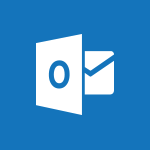Outlook Online - Customize your Outlook online Video
In this video, you will learn about customizing your Outlook Online experience.
The video covers how to access the Microsoft 365 portal and navigate through Outlook Online.
It demonstrates how to use features such as the calendar, ribbon layout, and folders to organize your emails effectively.
This will help you personalize your Outlook Online experience and increase your productivity.
Stay tuned for more videos on searching, sorting, and filtering options in Outlook Online.
- 1:56
- 2075 views
-
Excel - Create a PivotTable and analyze your data
- 1:35
- Viewed 3869 times
-
Power BI - Recovering your Data from different sources
- 3:26
- Viewed 4095 times
-
Power BI - Creating your Datasets
- 2:26
- Viewed 3577 times
-
Power BI - Introduction to Power BI Building Blocks
- 3:07
- Viewed 4021 times
-
Power BI - Introduction to Power BI Desktop
- 2:52
- Viewed 3971 times
-
Power BI - General Introduction
- 2:54
- Viewed 4922 times
-
Outlook - Manage attachments
- 1:51
- Viewed 2863 times
-
Excel - Use slicers, timelines and PivotCharts to analyze your pivotetable data
- 3:38
- Viewed 2615 times
-
Answering a scheduling poll
- 1:14
- Viewed 7056 times
-
How to recall or replace a sent email in Outlook Web
- 0:53
- Viewed 6620 times
-
Use the scheduling poll dashboard
- 2:42
- Viewed 4289 times
-
Accessing applications from a group
- 1:59
- Viewed 3731 times
-
Creating a group
- 2:38
- Viewed 3612 times
-
Customize Action Buttons in Outlook Online
- 2:17
- Viewed 3590 times
-
How to filter and sort your emails
- 3:03
- Viewed 3164 times
-
Having a conversation within a group
- 3:21
- Viewed 2878 times
-
Introduction to Outlook Online
- 3:10
- Viewed 2488 times
-
How to search in the Outlook Web App
- 0:56
- Viewed 2463 times
-
Reply, reply to all or transfer
- 1:46
- Viewed 2327 times
-
Attachments and sending options
- 1:45
- Viewed 2325 times
-
Out-of-office messages and automatic replies
- 1:54
- Viewed 2181 times
-
Create and embed a signature
- 1:25
- Viewed 2142 times
-
Turning emails into actionable tasks
- 1:35
- Viewed 2092 times
-
Creating quick accesses and favorites
- 1:32
- Viewed 2051 times
-
Adding contacts with Outlook Online
- 1:29
- Viewed 2033 times
-
Managing your contacts
- 1:25
- Viewed 1988 times
-
Responding to a meeting invitation
- 1:48
- Viewed 1984 times
-
Creating and using email templates
- 1:02
- Viewed 1977 times
-
Mastering contact lists and groups
- 2:02
- Viewed 1973 times
-
Getting familiar with the calendar features
- 2:06
- Viewed 1951 times
-
Select multiple emails in Outlook Web App
- 1:52
- Viewed 1944 times
-
Managing your tasks with To Do add-in
- 2:04
- Viewed 1942 times
-
Organizing and navigating with categories
- 1:37
- Viewed 1908 times
-
Creating Tasks in Outlook Online
- 2:04
- Viewed 1834 times
-
Setting up a meeting with Outlook Online
- 1:47
- Viewed 1828 times
-
Creating and managing folders
- 1:29
- Viewed 1792 times
-
Setting up and managing calendar shares
- 1:39
- Viewed 1775 times
-
Automating email processing with rules
- 2:35
- Viewed 1752 times
-
Sharing your calendar in Outlook Online
- 1:37
- Viewed 1692 times
-
Introduction to PowerBI
- 00:60
- Viewed 213 times
-
Introduction to Microsoft Outlook
- 01:09
- Viewed 209 times
-
Introduction to Microsoft Insights
- 02:04
- Viewed 217 times
-
Introduction to Microsoft Viva
- 01:22
- Viewed 218 times
-
Introduction to Planner
- 00:56
- Viewed 215 times
-
Introduction to Microsoft Visio
- 02:07
- Viewed 215 times
-
Introduction to Microsoft Forms
- 00:52
- Viewed 216 times
-
Introducing to Microsoft Designer
- 00:28
- Viewed 313 times
-
Introduction to Sway
- 01:53
- Viewed 220 times
-
Introducing to Word
- 01:00
- Viewed 213 times
-
Introducing to SharePoint Premium
- 00:47
- Viewed 194 times
-
Create a call group
- 01:15
- Viewed 289 times
-
Use call delegation
- 01:07
- Viewed 170 times
-
Assign a delegate for your calls
- 01:08
- Viewed 286 times
-
Ring multiple devices simultaneously
- 01:36
- Viewed 171 times
-
Use the "Do Not Disturb" function for calls
- 01:28
- Viewed 164 times
-
Manage advanced call notifications
- 01:29
- Viewed 179 times
-
Configure audio settings for better sound quality
- 02:08
- Viewed 238 times
-
Block unwanted calls
- 01:24
- Viewed 200 times
-
Disable all call forwarding
- 01:09
- Viewed 181 times
-
Manage a call group in Teams
- 02:01
- Viewed 184 times
-
Update voicemail forwarding settings
- 01:21
- Viewed 174 times
-
Configure call forwarding to internal numbers
- 01:02
- Viewed 168 times
-
Set call forwarding to external numbers
- 01:03
- Viewed 192 times
-
Manage voicemail messages
- 01:55
- Viewed 263 times
-
Access voicemail via mobile and PC
- 02:03
- Viewed 299 times
-
Customize your voicemail greeting
- 02:17
- Viewed 167 times
-
Transfer calls with or without an announcement
- 01:38
- Viewed 168 times
-
Manage simultaneous calls
- 01:52
- Viewed 178 times
-
Support third-party apps during calls
- 01:53
- Viewed 222 times
-
Add participants quickly and securely
- 01:37
- Viewed 185 times
-
Configure call privacy and security settings
- 02:51
- Viewed 179 times
-
Manage calls on hold
- 01:20
- Viewed 173 times
-
Live transcription and generate summaries via AI
- 03:43
- Viewed 166 times
-
Use the interface to make and receive calls
- 01:21
- Viewed 180 times
-
Action Function
- 04:18
- Viewed 175 times
-
Search Function
- 03:42
- Viewed 226 times
-
Date and Time Function
- 02:53
- Viewed 210 times
-
Logical Function
- 03:14
- Viewed 337 times
-
Text Function
- 03:25
- Viewed 234 times
-
Basic Function
- 02:35
- Viewed 199 times
-
Categories of Functions in Power FX
- 01:51
- Viewed 236 times
-
Introduction to Power Fx
- 01:09
- Viewed 222 times
-
The New Calendar
- 03:14
- Viewed 364 times
-
Sections
- 02:34
- Viewed 214 times
-
Customizing Views
- 03:25
- Viewed 202 times
-
Introduction to the New Features of Microsoft Teams
- 00:47
- Viewed 393 times
-
Guide to Using the Microsoft Authenticator App
- 01:47
- Viewed 235 times
-
Turn on Multi-Factor Authentication in the Admin Section
- 02:07
- Viewed 180 times
-
Concept of Multi-Factor Authentication
- 01:51
- Viewed 219 times
Objectifs :
This document aims to guide users on how to customize the appearance and organization of their mailbox in the new Outlook on the web, enhancing their email management experience.
Chapitres :
-
Introduction to Customizing Your Mailbox
In the new Outlook on the web, users have the ability to change the look and feel of their mailbox. This customization allows for a more personalized and efficient email management experience. This guide will walk you through the various options available for adjusting the appearance and organization of your mailbox. -
Accessing Settings
To begin customizing your mailbox, navigate to the upper right corner of the Outlook interface and click on the star wheel icon, which represents the Settings menu. This will open a window where you can modify various aspects of your mailbox. -
Changing Appearance
Within the Settings menu, select 'General' and then 'Appearance'. Here, you can choose between Light mode and Dark mode. - **Light Mode**: This is the default setting, featuring a white background for the message window. - **Dark Mode**: Selecting this option changes the background to black, which can be easier on the eyes in low-light environments. You can also explore 'Classic Themes' to select a theme that alters the color and overall aesthetic of your mailbox. Remember to click 'Save' to apply any changes. -
Enabling Notifications
Under the Notifications section, you can enable desktop notifications. This feature allows you to receive alerts for events or messages even when Outlook is closed, as long as your browser remains open. You can choose to receive notifications for: - Events - Messages - Both -
Organizing Your Inbox
To help you focus on important emails, navigate to 'Mail' and then 'Layout'. Here, you can enable the 'Focused Inbox' feature by checking the option to 'Sort messages into Focused and Other'. This organizes your emails into two tabs, helping you prioritize your inbox effectively. -
Adjusting Text Size and Spacing
In the same Layout section, you can adjust the text size and spacing. Choose from: - Small - Medium - Large This setting ensures that your emails are easy to read, with ample white space between sentences and paragraphs. -
Grouping Emails by Conversation
To enhance message organization, you can enable the option to 'Show email grouped by Conversation'. This feature groups all messages with the same subject line into a single thread, making it easier to follow discussions. If this option is enabled, you can also arrange the Reading pane to determine the chronological order in which emails appear. -
Configuring the Reading Pane
You can customize the Reading pane's position to suit your preferences. Decide whether you want it to appear on the right side, below, or not at all, allowing for a more tailored reading experience. -
Conclusion
By following these steps, you can effectively change the look and organization of your mailbox in the new Outlook on the web. Customizing your email interface not only enhances your productivity but also creates a more enjoyable email experience.
FAQ :
How can I change the appearance of my mailbox in Outlook on the web?
To change the appearance of your mailbox in Outlook on the web, click on the star wheel in the upper right corner to open the Settings window. From there, you can select options under 'General' and 'Appearance' to switch between Light and Dark modes, choose Classic Themes, and adjust other visual settings.
What is the difference between Light mode and Dark mode in Outlook?
Light mode features a white background with dark text, while Dark mode provides a black background with light text. Dark mode is designed to reduce eye strain in low-light conditions.
What are desktop notifications in Outlook on the web?
Desktop notifications are alerts that inform you of new emails or events in Outlook, even when the application is closed but your browser is open. You can enable these notifications in the Settings under 'Notifications'.
How does the Focused Inbox feature work?
The Focused Inbox feature sorts your incoming emails into two tabs: 'Focused' for important messages and 'Other' for less important ones. You can enable this feature in the Mail settings under 'Layout'.
Can I group emails by conversation in Outlook?
Yes, you can group emails by conversation in Outlook. To enable this feature, go to the Message Organization settings and check 'Show email grouped by Conversation'. This will display all messages in the same thread together.
Quelques cas d'usages :
Customizing Email Appearance for Better Focus
A marketing professional can use the Dark mode feature in Outlook on the web to reduce eye strain during long hours of email management. By customizing the appearance with Classic Themes, they can create a visually appealing workspace that enhances focus and productivity.
Managing Notifications for Increased Efficiency
A project manager can enable desktop notifications for important emails while keeping Outlook closed. This allows them to stay updated on critical messages without being distracted by less important notifications, thus improving their workflow.
Organizing Emails for Better Collaboration
A team leader can utilize the Focused Inbox feature to prioritize important emails from team members. By sorting messages into Focused and Other, they can ensure that they address critical communications promptly, enhancing team collaboration.
Enhancing Readability with Text Size Adjustments
An HR professional can adjust the Text Size and Spacing settings in Outlook to improve readability for their emails. By selecting a larger font size and ample spacing, they can ensure that their messages are clear and easy to read for all recipients.
Streamlining Email Conversations
A customer support agent can enable the Show email grouped by Conversation feature to streamline their email management. This allows them to view all related messages in a single thread, making it easier to track ongoing discussions and respond efficiently.
Glossaire :
Outlook on the web
A web-based version of Microsoft's Outlook email client that allows users to manage their emails, calendars, and contacts through a web browser.
Settings window
A menu in Outlook where users can customize their preferences and configurations for the application.
Message list
The area in Outlook where all received emails are displayed, allowing users to select and read messages.
Reading pane
A section in Outlook that allows users to read the content of an email without opening it in a new window.
Light mode
A visual theme in Outlook characterized by a white background and dark text, providing a bright interface.
Dark mode
A visual theme in Outlook that features a black background and light text, designed to reduce eye strain in low-light environments.
Classic Themes
Predefined color schemes in Outlook that allow users to change the overall appearance of their mailbox.
Desktop notifications
Alerts that appear on the user's desktop when new emails or events occur in Outlook, even when the application is not actively open.
Focused Inbox
A feature in Outlook that sorts incoming emails into two tabs: 'Focused' for important messages and 'Other' for less important ones.
Text Size and Spacing
Settings in Outlook that allow users to adjust the font size and the amount of space between lines and paragraphs in their emails.
Message Organization
Settings that determine how emails are grouped and displayed in Outlook, such as by conversation threads.




